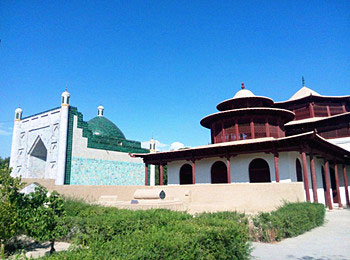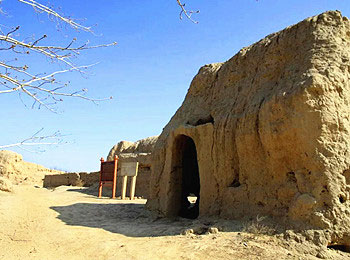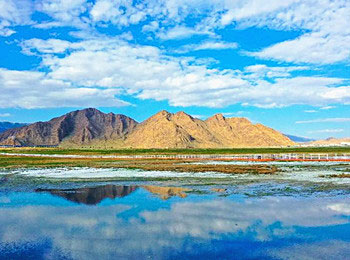Hami Hiking Tours
Hami 01: 2 Days Tour to Hui King Mausoleum
Day 01: Hami
Hami, in east Xinjiang Province, is the first city you come across by train from heartland China. Hami went through many name changes on record and it settled for "Hami" in 1913. We witness the ravages of history everywhere in Hami. Let's start the two-day tour from Hami.
Visit the Gaisi Tomb and the Hui King Mausoleum. Gaisi, the third disciple of Nabi Mohamed, was invited by the Emperor Taizong of Tang Dynasty to come to China with two followers as Islamic missionaries. One of the missionaries died en route and Gaisi and the other perished in Xingxing Valley near Hami on their homeward journey. The King Hui of Hami had erected an arch bridge in his memory. Gaisi's remains were interred 1300 years later in the west suburb of Haili City and there a newer 10-meter high Muslim style tomb was built by the faithful. It is also called the "Saint Tomb".
Islam regards making the Hajj a lifetime goal. Thousands of Muslims spend their life savings on a pilgrimage to Mecca. Others come to the Gaisi Tomb as a modest alternative. Admission to the Tomb is free. You may either take the taxi or the tourist bus to get to the Gaisi Tomb. After the visit, take a taxi to the Hui King Mausoleum. It is also within walking distance from the Gaisi Tomb for the sure footed. The Hui King Mausoleum really is the tomb of the Hami King Hui III. On a vast tract of land, the Tomb and its history will take you hours to cover. Also, the largest mosque in Hami is nearby, beckoning you for a visit. Stay overnight at Hami Hotel (Address: No. 4, Yingbin Road, Hami, Xinjiang; Telephone: 86-902-2233140).
Day 02: Hami
You could rent a car for a trip to the Eight Stones and the Maier Valley in the morning, and then on to the Caved Buddha Temple in the afternoon. Miaoer Valley is 25 kilometers from Hami City, near the Huangtian Pasture. You come to the ruins of the summer palace belonging to Hami Hui King IV. Some traces of the once grand wall paintings are still evident. Then, drive on to the Eight Stones, named after the eight pieces of stone of various shapes and sizes. Like the Miaoer Valley, it was a summer palace and the orchard of the Hami Hui King. In the afternoon visit the Caved Buddha Temple. The Temple is the relic of the Buddhism Cave Temple. The Buddhist images in caves were excavated in the crags along the Baiyang Valley. You can still see some relics in the caves.

Hui King Mausoleum

Lapuqiaoke Ancient City
Hami 02: 2 Days to Lapuqiaoke Ancient City and Wubao Ghost City
Day 01: Hami - Lapuqiaoke Ancient City - Wubao Ghost City
This two day itinerary covers the popular and classical route of western Hami. You can allow free rein to your imagination, and to your heart desire in the Wubao Ghost City and the Lapuqiaoke Ancient City.
The Wubao Ghost City is located 20 kilometers south of Wubao Village and 100 kilometers southwest of Hami City. For new comers, it will not be so easy to find the right way. If you got lost in the Gobi desert, it will be very dangerous. Considering this factor, we kindly suggest the visitors to charter a car with an experienced local guide.
Your first stop will be the Lapuqiaoke Ancient City which is 65 kilometers to the east of Hami City. It was a relic of the city in the Tang Dynasty. In 1957, it was granted the province-level status of cultural relic protection. Judging from the vast land, the ancient city was constructed on a large-scale incorporating the north and the south city. The layout of the two halves is shaped like the Chinese character "?". That is, the construction of the two similar parts in some kind of symmetry. Nowadays, houses have been built and orchards have cultivated. In some area, there are some faintly visible sites left. Aside the city, sites like a former Buddhist temple and beacon tower can be traced. Then drive to the Wubao Ghost City to stay overnight. Together with Qitai Ghost City in Qitai County, the Wuerhe Ghost City in Karamay, Kerzier Ghost City in Baicheng County, the Wubao Ghost City are reputed as the four great ghost cities in Xinjiang Province and it is the most famous one among them. After years of erosion by wind and rain, the ground shows stratified black oil-like layers of sand in waves. With the changing sunlight at different times of day, the land metamorphosis's and becomes increasingly mysterious. Take some pictures of the sun set here. When the sun sets, there will be some horrent bray with wind. Anybody in this case will surely feel the hair on the back of their neck stand on end.
Day 02: Wubao Ghost City - Hami
Continue to explore the Ghost City and take pictures. We suggest you get up very early to watch the constantly changing vista driven by the sunlight. In the area, anyone will give free rein to their imagination. You may also visit the Aisikeer Old Castle which is the located 18 kilometers from the front gate of the Ghost City Resort. You may get interested in it as it is the holy land in the hearts of the local people. Due to the bone-dry and very hot local climate, over 113 tumuli with a good many cultural relics such as mummies have been found in this area. With the tour now finished return to the city.
Hami 03: 2 Days Hami - Balikun Lake - Grotesque Rock Mountain - Echoing-Sand Dune - Hami
Day 01: Hami - Balikun Lake - Grotesque Rock Mountain
The best times to take this tour are autumn or winter. On the first day, you will visit the Balikun Lake and Grotesque Rock Mountain. There are two ways to get there. One way is to take a coach from Hami Passenger Station to Balikun County and then take a taxi or local tractor to the township sights. The other way is to charter a car from Hami directly. Of course, the price will be lower if you have some fellow travelers to share the transfer fee with you. If you go by car, just drive north along the No. 203 Provincial Road for about two hours and you will reach the Balikun County. The Balikun Lake is located in the northwest part of the County and the Grotesque Rock Mountain is 7 kilometers north of the Lake. The Balikun Lake was also called "Puleihai" which is a hero's name in the local folklore regarding the Lake. The lake is divided into east and west parts by a sandstone mound. During holidays, people from nearby Kazakhstan hold their folk singers' festival, which is called the "A Ken Tan Chang Hui". "A Ken" is a generally name for the Kazakhstan folk singers. Later, drive to the Grotesque Rock Mountain to the north. The highlights of the mountain are the extensive caves of various sizes and shapes. Thousands of wild pigeons inhabit the caves and build their nests there. Besides the caves, you can also visit the famous Jinger Spring in the Grotesque Rock Mountain Resort. Return to Balikun County for your overnight stay. We suggest: Balikun Hotel (No. 2, Yucai Road, East Hancheng Street, Balikun County, Hami, Xinjiang)
Day 02: Echoing-Sand Dune - Hami
Drive to the Echoing-Sand Dune which is in Baishi (White Stone) Town. Maybe you have heard of the Echoing-Sand Dune before, but this Echoing-Sand Dune is not the one in Dunhuang. In fact, there are four great Echoing-Sand Dunes in China. They are the Hami Echoing-Sand Dune in Xinjiang province, the Dunhuang Echoing-Sand Dune in Gansu Province, Zhongwei Shapotou in Ningxia Hui Nationality Autonomous Region and the Ordos Resonant Sand Gorge in Inner Mongolia. The sand itself can not make any sound. The echo is a natural phenomenon that occurs when people slide down the sand. You may take some pictures of the sand and the spring in the resort. For relaxation, drive to the nearby Baishi (White Stone) Resort. The resort is made up of grassland, virgin forest and the vacation village. The resort got its name from a white stone as large as a herd of cattle. This concludes the tour finished and you can return to Hami before evening.

Balikun Lake

Echoing-Sand Dune